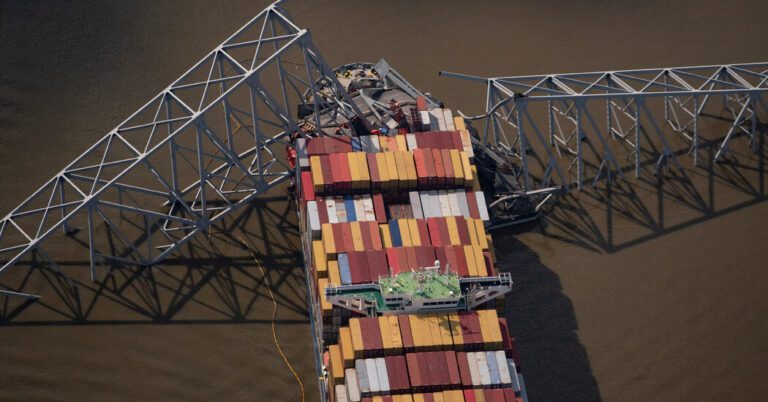
[ad_1]
President Biden plans on Friday to visit the site of the Baltimore bridge that collapsed after a colossal cargo ship plowed into it last week, killing six people and severing a major shipping and transportation artery.
During his visit to the wreckage of the Francis Scott Key Bridge, Mr. Biden will take an aerial tour, receive briefings on the response efforts and meet with the families of construction workers who were plunged into the Patapsco River along with the structure.
Mr. Biden is set to encounter a more than mile-long tangle of concrete and steel that has snarled traffic, devastated blue-collar communities and disrupted operations at one of America’s biggest ports, threatening chaos that could ripple across supply chains.
The president has already pledged federal support to help the city recover from the March 26 catastrophe, including a vow to “pay for the entire cost of reconstructing” the bridge “as soon as humanly possible.” It was unclear whether he would announce new measures during his visit, such as an emergency funding package that would need congressional approval. Some Republicans have already rebuffed his promise to pay the entire bridge cost.
Karine Jean-Pierre, the White House press secretary, said on Thursday that Mr. Biden would gather more information about what aid was needed during his visit, and pointed to support the federal government had already provided.
“The president is continuing to lead a whole-of-government approach in responding to the bridge collapse,” she said. “As the president said within hours of the collapse, this administration will be with the people of Baltimore every step of the way.”
This week, senior administration officials called major employers in the Baltimore area, including retail chains such as Home Depot and distributors like Amazon, to encourage them to retain workers, Ms. Jean-Pierre said.
Since the collapse, the administration has funded the harbor cleanup, unlocked $60 million in emergency funding to help rebuild the bridge, provided low-interest disaster loans to affected businesses and overseen efforts to monitor and manage any supply chain disruptions.
The structure, which took five years to build, opened in 1977 and served as a critical transportation link on the East Coast, carrying more than 30,000 vehicles a day as they traveled on Interstate 695. It was named after Francis Scott Key, the Maryland-born author of “The Star-Spangled Banner.”
The bridge crumbled in the dead of night when a 985-foot-long cargo vessel plowed into it shortly after departing the Port of Baltimore, a vital economic engine that handles more cars and farm equipment than any other port in the country. The vessel, the Dali, lost power before it hit the bridge but sent a mayday call that gave officials enough time to halt bridge traffic.
But it was not enough time to get to workers who were already on the bridge.
Six construction workers were missing after the collapse, and the bodies of two of them were recovered from the river on March 27. Recovery efforts for the remaining workers, who are presumed dead, were suspended. The authorities said the bodies were most likely encased in steel and concrete.
“They were hard workers laboring in the middle of the night to repair potholes on a bridge that tens of thousands of travelers crossed every day,” Ms. Jean-Pierre said.
[ad_2]